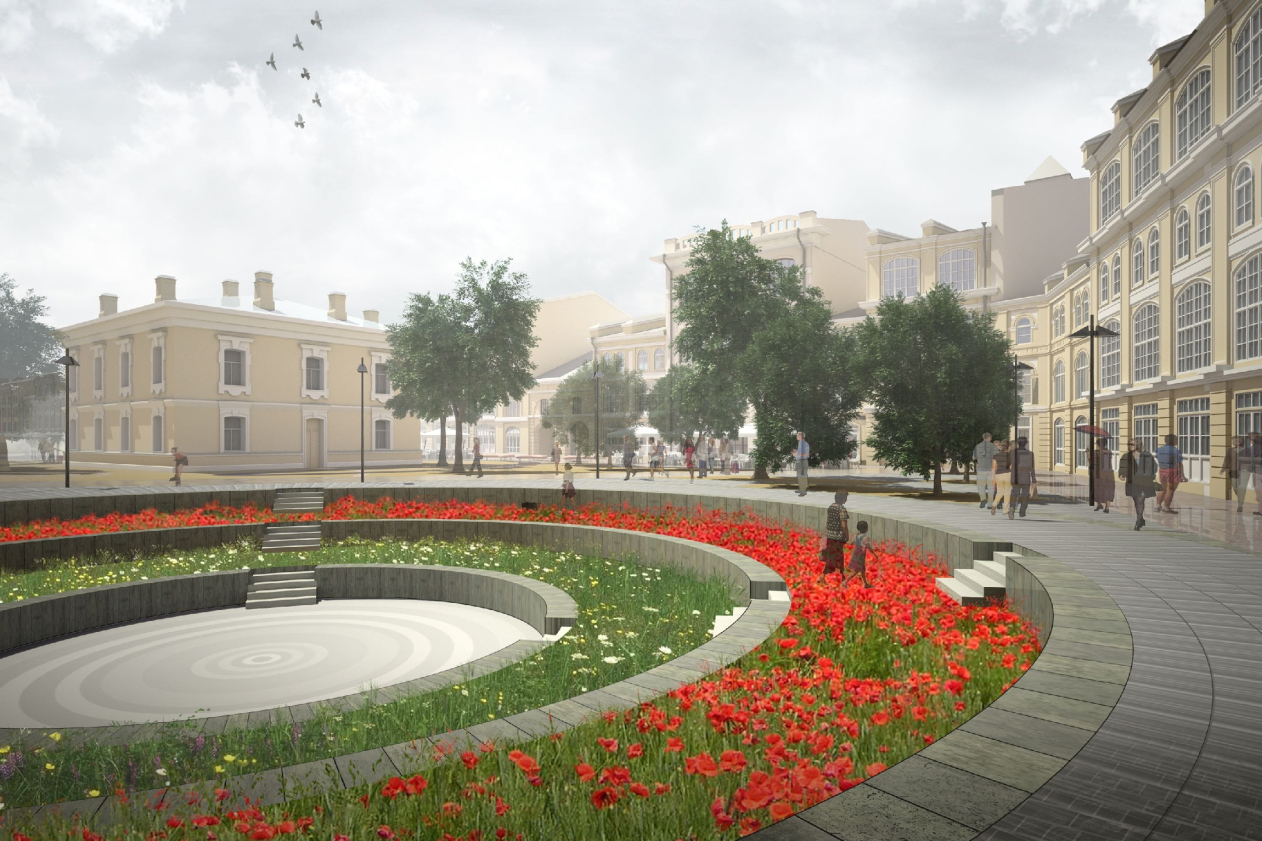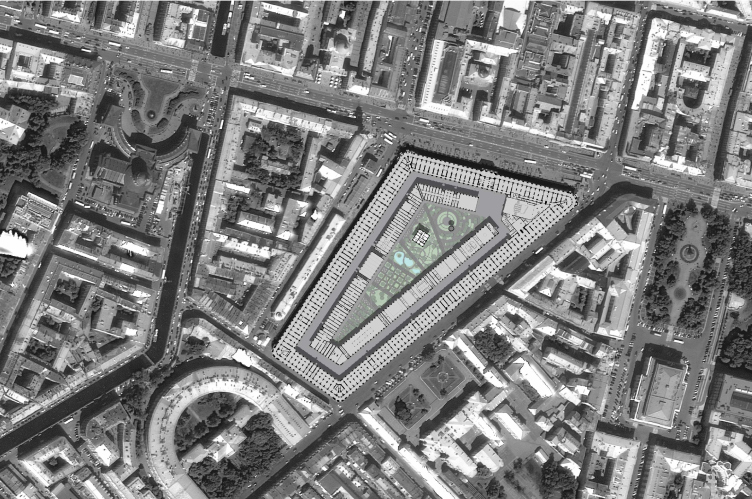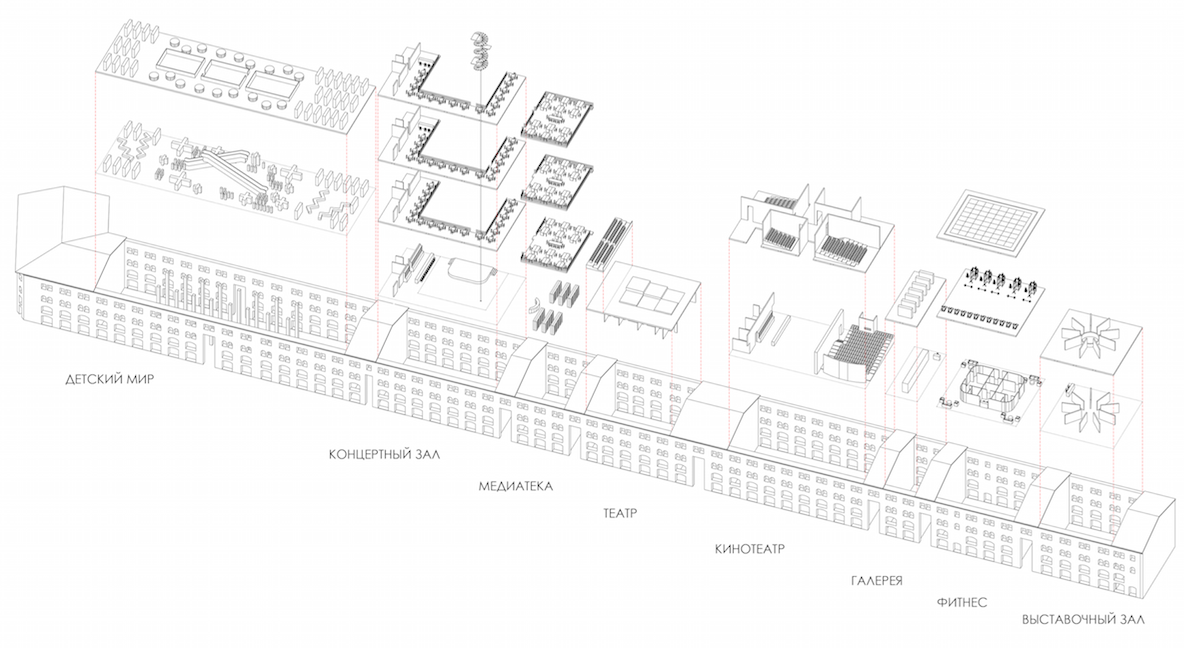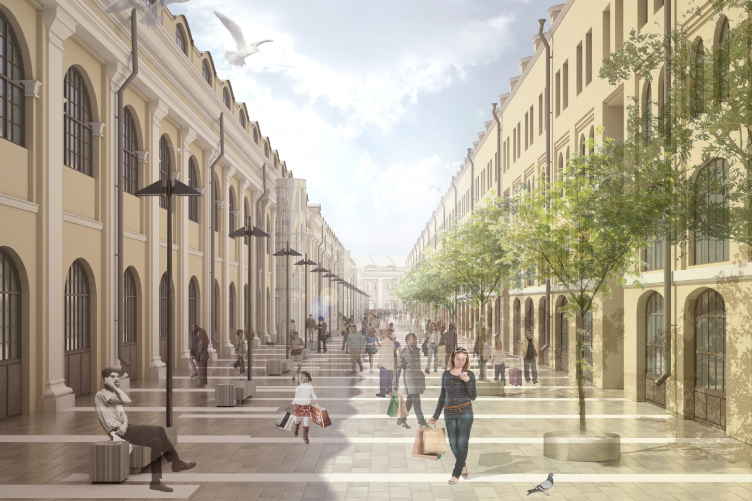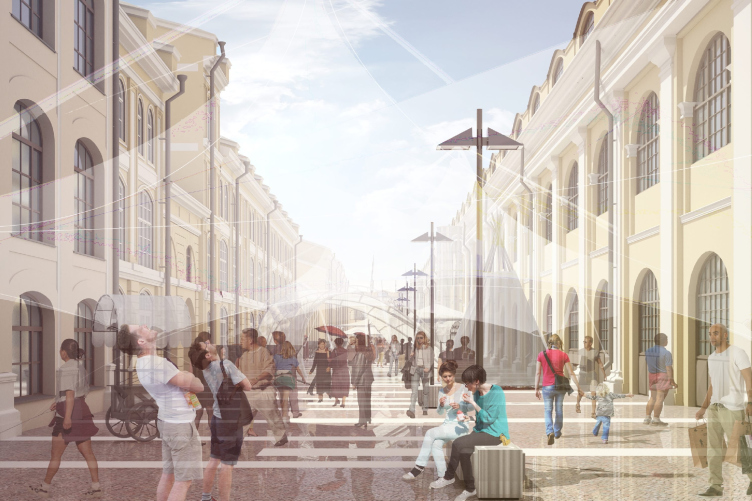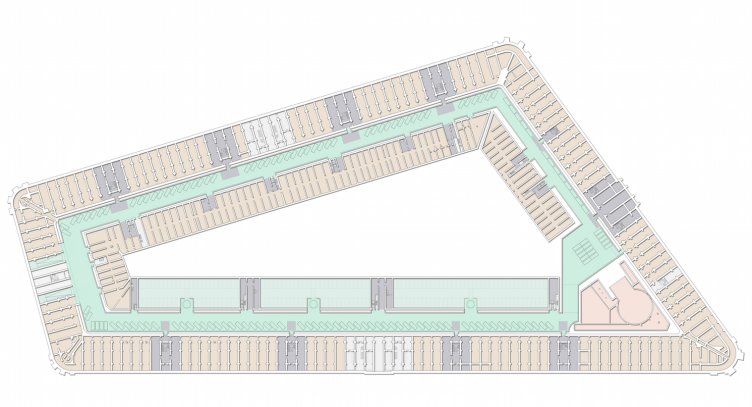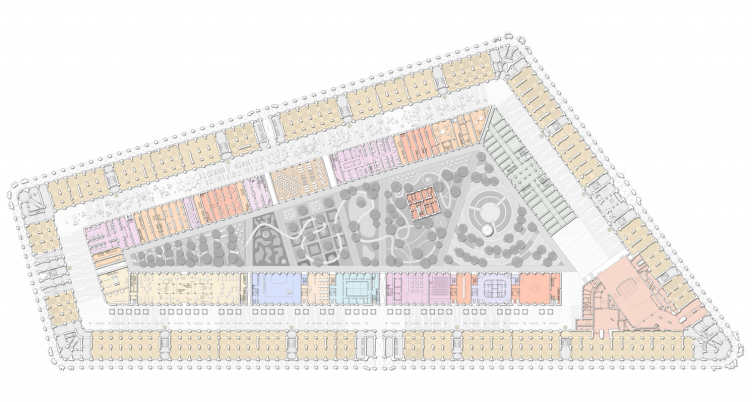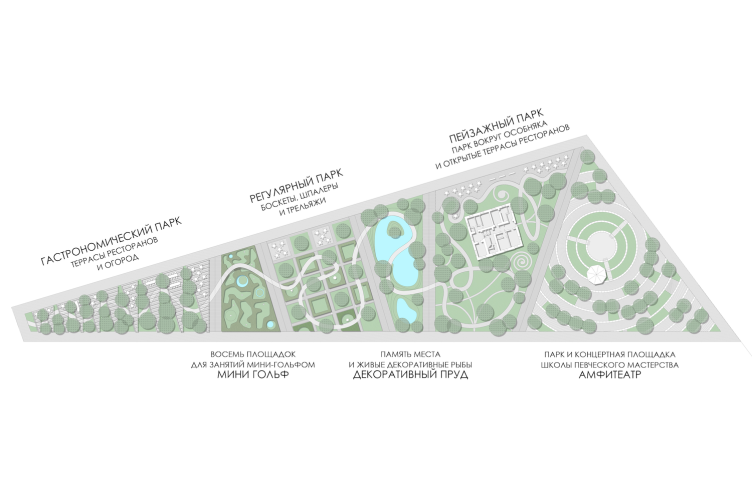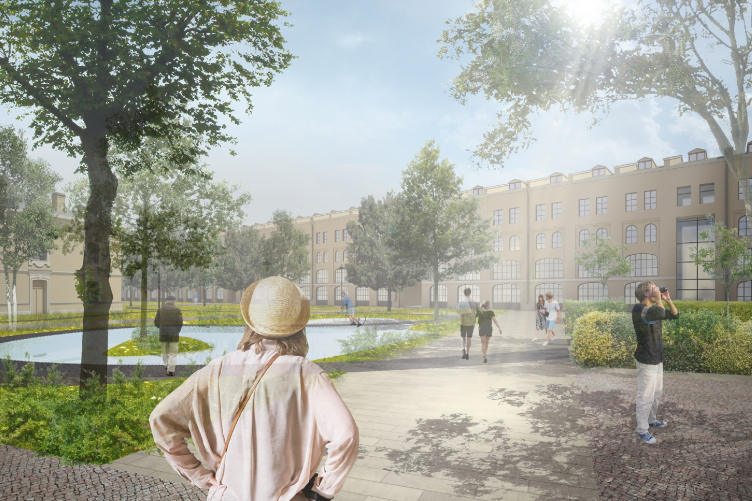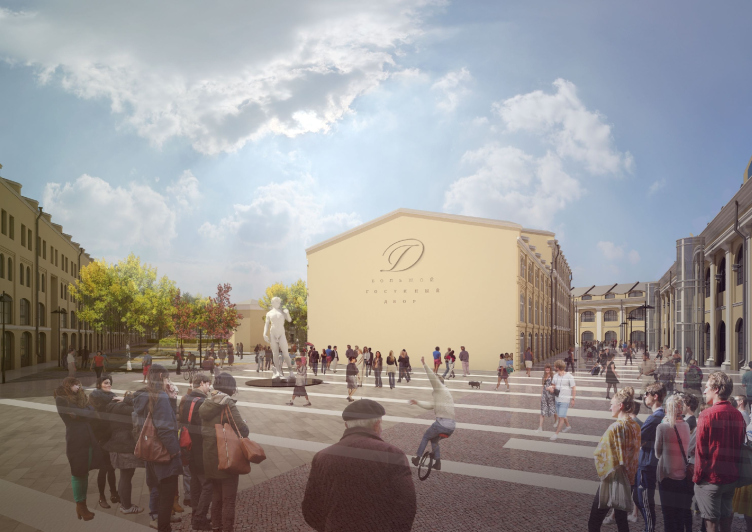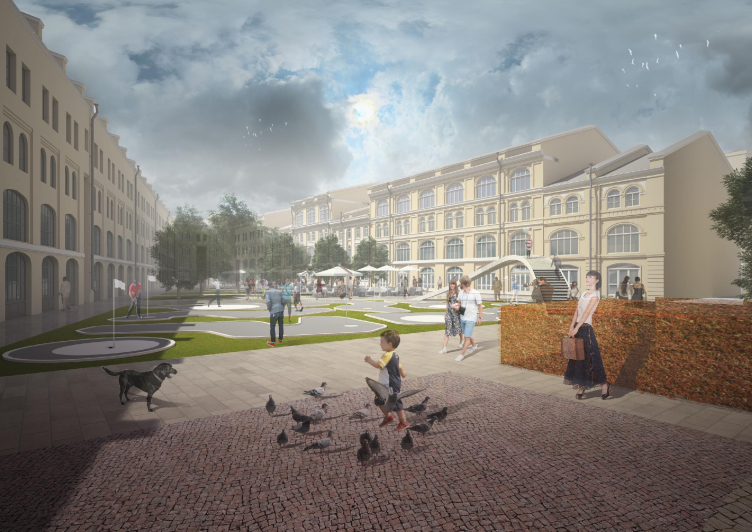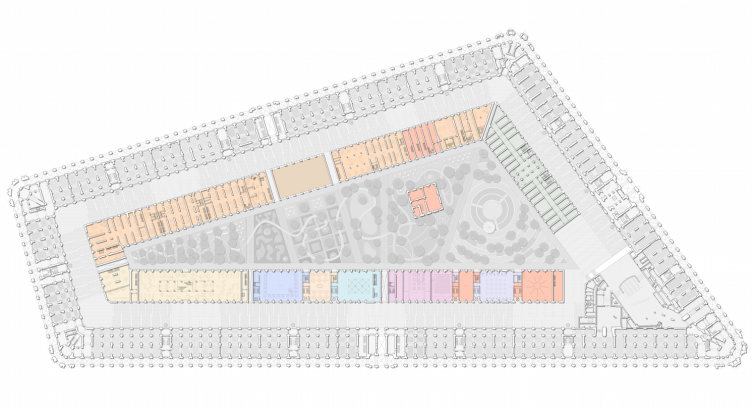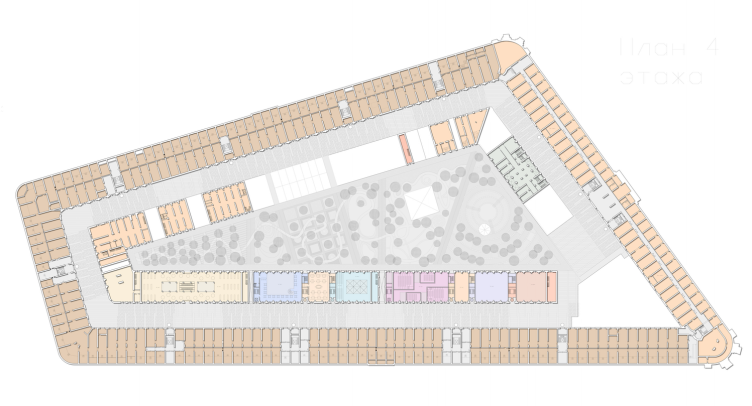The city of Saint Petersburg is planning to reconstruct Gostiny Dvor upon the project of Nikita Yavein's "Studio 44". Last year in December, the project was approved by Saint Petersburg's Committee on State Control, Use and Protection of Historical and Cultural Landmarks, and, as the industry media reports, by 88% of the customer company's board of directors. According to the project, "Gostinka" is going to turn, from a post-soviet shopping center, into a multifunctional complex with a highly developed public area, museums and restaurants of its own, an underground parking garage, and a one-hectare public park. Inside Gostiny Dvor, now already - also upon the project of "Studio 44" - the reconstruction of Unit B is being completed, the so-called "Brest Fortress", for Elena Obraztsova Music Academy; in the future it must become an integral part of the cultural space inside the shopping complex.
It must be recognized here that Saint Petersburg's Gostiny Dvor is indeed a landmark building: this is the city's first stone "guest house" of the European type that came to change the medieval shopping arcades, being different from them in its order and magnitude. After the appearance of Saint Petersburg's main Gostiny Dvor, the shopping arcades started to get rebuilt in many other areas of Saint Petersburg as well as in Moscow and in many other Russian cities, first of all, standing along the Volga River. In a word, the building that stands on the Nevsky Prospect is not just chronologically the first project that was started in the empire's capital in the classicism style at the will of Catherine the Great, and not only the creation of Jean-Baptiste Vallin de la Mothe who used parts of Rastrelli's original plan who, in turn, proceeded from Rinaldi's project, all of them being the world's top architects of those days, which speaks for itself as it is - Gostiny Dvor is just as much of a symbol of Saint Petersburg as the very Nevsky Prospect. Over the decades, the building was significantly rebuilt, though: being hit by a Nazi bomb during the war, it suffered from a fire, and, after it was restored in the sixties, upon the project of Oleg Lyalin, its inside structure was changed: the walls of the "shops", hitherto "see-throng", i.e. isolated from one another but opened both ways for entering and exiting, were now "punched through" and strung onto the inside enfilade - this was meant to turn the "bourgeois" shopping arcades into a decent "soviet" department store. The acute angle of the irregular for-square at the crossing of Nevsky Prospect and the Sadovaya Street got a subway exit. Then the yard started to get overbuilt with utility facilities, and there appeared the rough-looking passages between the units.
It must also be mentioned at this point that Saint Petersburg's Gostiny Dvor that neatly "belts up" its land site along the perimeter of some five-hectare area, has an inner contour of buildings inside of it, standing back some ten meters from the outer one: presently, the inner buildings are used as warehouses and most of the visitors do not even have a clue about their existence. The buildings of the inner circle, in turn, belt up the triangular courtyard - when designing, in the mid XVIII century, his version of shopping arcades looking a lot like the winter palace, Rastrelli conceived them as having a park and a pond in their yard - but the expensiveness of the "lush" project was opposed by the merchants themselves because they were actually the ones who financed the construction. The classicist project by Vallin de la Mothe turned out to be the more rational one; the yard even got the intended pond, but of a strictly fire-safety nature: in spite of the ban imposed on using the candles, there was always something on fire in Gostiny Dvor back in those days. The yard took on a purely utilitarian character: Gostiny Dvor always required more space for storing rather than selling, and even now but 17% of the entire area are used for actual shopping, the other 83% being used for the utility purposes. The project of "Studio 44", at the expense of streamlining the costs, will increase the shopping area by some 10-15%.
Thus, Nikita Yavein proposed, first of all, to clear the building from the layers of the soviet time, and bring it back to the state of approximately 1917, restoring, among other things, the fractions of Art Nouveau and the "order-less" classicism of the yard buildings. Further on - and this is one of the most important things about restoring Gostiny Dvor back to the "pre-revolution" status - the walls of the shops, earlier punctured by the enfilade of the department store, are also restored to their original configuration, while the building on the whole get back its "pre-revolution" structure. In some cases, however, some neighboring premises will be united because today's stores do require more space. The shop entrances will be opened up into the street as well as into the passage between the building's inner and outer contours.
The current state © Studio 44
Location Plan © Studio 44
The stages © Studio 44
As this "inner" passage is concerned, the architects are planning to clear it completely from the later-on additions and turn it into a pedestrian city street easily accessible from any of the shops or from the subway - with efficient landscaping, paving, trees in tubs, benches, but still open-air, without the glass roof overhead. "What we are now doing is we are creating pedestrian streets in this city, making then car-free and getting still more problems with the city traffic because of this. Here, however, we've got at our disposal the part of the city that has never been open to the automotive traffic, and, by making it pedestrian-only, we do not intrude into the existing structure but only develop and enrich it" - Nikita Yavein comments.
The result looks like a cross between a passage and a city street designed in the vein of historical and tourist centers of the European cities so much loved by the Russians due to the sheer absence of such scenery in this country. All the more so, because trading will take place on this street not from all sides: the buildings of the inner circle will be used for cultural purposes, they will house, among other things, the museum of Russian Merchants, art galleries, a fitness club, a concert hall, a theater, a movie theater, "Children's Paradise", and other cultural and entertainment establishments. The western part of the outer contour of Gostiny Dvor along the Perinnaya Street will be given to restaurants.
The new functions of the inside buildings © Studio 44
Gostiny Dvor. Inside streets, the Sadovaya Line © Studio 44
Gostiny Dvor. Inside streets, the Pevcheskaya Line © Studio 44
Under the inner pedestrian street, the architects placed one tier of the underground parking garage, while under the southwest line of the inside buildings - four tiers. Together, they will yield 700 car stalls, while the driving entrance is designed in the farther end, opposite to Nevsky Prospect, near the Lomonosovskaya Street.
Plan of the first floor © Studio 44
And, finally, the main theme of the "reformed" Gostiny Dvor, a climax of sorts, is the park with a pond that the architects, following Rastrelli's idea, actually make in the yard. The sharp triangle of the plan widens in the direction of Nevsky Prospect organizing the space in a perspective fashion, putting one in the mind of the enfilade in the Joint Staff building but in this case the resemblance is accidental because there are many such triangular plans in Saint Petersburg, conditioned by the sheer density of the buildings.
But then again, however, what the architects get inside looks rather like a cross between English and French park based on today's techniques of contemporary urban landscaping. On getting out of the metro, we see a circular amphitheater lawn, even a micro-Coliseum, covered with flowers and containing the round shaft of the metro air conditioning - meant, among other things, for the concerts of the local singing school. This small square is a public place convenient for organizing various events. Further on, the park is dissected with diagonal slashes into five more different parts connected with a willfully winding trail. Behind the amphitheater, there is an English park, of the "conditionally landscape" type, due to the fact that the space is limited, the park has in it the management committee of Gostiny Dvor, finished with neo-empire rock face and slashed with pseudo-baroque windows - but the first glance at such project graphics puts one in the mind of Saint Petersburg's Summer Garden. The house, it must be said, has already been renovated and it is also going to house the Museum of Russian Merchants. Still further on, there is the decorative pond that is, according to the authors' idea, "responsible for the memory of the place" - meaning, is reminiscent both of the old fire protection pond and about Rastrelli's concept, or, maybe, even about the swamp that once was there where now the Perinny Ryad is, the one that Elizabeth the Empress ordered so many times to dry in vain. In the center of the park one will see the climax of the reminiscences of the XVIII century: the "boskets, espaliers, and trellises" dissected into chessboard fields - soon replaced, however, by the quite contemporary entertainment of mini-golf, while the sharp end of the triangle presents a true nosh-up: the open-air terraces of the restaurant's alternate here with the wedges of the kitchen garden. Incidentally, this same empress Elizabeth liked it when the parks of her residences had currants growing in them - during her walks she loved nipping the berries off the bushes.
Plan of the first floor © Studio 44
Map of the inside park © Studio 44
Gostiny Dvor. Inside park, ponds © Studio 44
Gostiny Dvor. Inner square © Studio 44
Gostiny Dvor. Amphitheater © Studio 44
Gostiny Dvor. Courtyard, mini-golf fields © Studio 44
In a word, what we ultimately have here is not even a store but some "king's walk". The image of the modern trade, with its necessary twist of glamour, music, and the inevitable "American" smiles of the shop assistants, the inevitable movie theater and food court is superimposed here on the just-as-settled theme of the center of this great historical city: the pedestrian street, the museums and theaters, the open-air amphitheater, the terraces of the restaurants... This is all, of course, suggested by the names of the emperors and the empresses, and the architects who left their mark at this place. Only as far as the "quiet corner of the historical city" is concerned, the architects find it in a place where it never actually existed: nowadays, ultimately, located on Nevsky Prospect and between two metro stations, Gostiny Dvor is a pretty busy, bustling, and, come right down to it, dusty place. Its courtyard is in fact a loading bay, the seamy side of the trading process. And this all gets transformed, becomes well-kept and tidy, cool and pleasant, especially by contrast with Nevsky Prospect. Following the laws of the city's historical center, this version of Gostiny Dvor connects the time-tested laws of shopping management and the rules of urban planning, so vital for the city people nowadays. So, what it all comes down to is that Gostiny Dvor, the architectural monument of, let us say, early capitalism, adapts to the realities of the postindustrial era with its hipsters, yuppies, or whatever. This might sound weird but, from the structural standpoint, what we have here is a project of redevelopment of an industrial park, only a really old one, connected with trade, and because of that very special; the essence of the process is similar, even though Mothe's colums make it a little bit more refined.
This, however, is not the only project of reconstructing Gostiny Dvor. "Studio 44" has been doing this project for more than ten years now. Back in 2005, the project looked a bit different, and now observing its transformations is a rather curios thing to do. On the one hand, the original version was more careful of the historical monument than it was the case with the reconstruction of Quarenghi's Gostiny Dvor in Moscow covered by a glass dome upon the project of Nodar Kancheli. As early as in 2005, the yard was meant to get a regular park and the stairways, in front of which the building of the Management Committee stood exactly like Trianon. In front of the metro exit, there appeared a rotunda, a two-level parking garage occupied the whole space under the yard, the inner streets were fully glazed passages, and a glass pavilion appeared on the "sharp" corner of the park, where now the kitchen garden is meant to be. It is already clearly seen from the description that the reviewed version of 2014 is far more tactful, especially when it comes to the underground parking garages and the glazing part. But then again, as Nikita Yavein says, he cannot entirely rule out the possibility that the glazing of the inside streets will have to stay: the cold and windy Saint Petersburg gives plenty of reasons for that.
There is also yet another project about which the industry media writes as about the one proposed by a minority stakeholder of about 10% of the shares of today's Gostiny Dvor, affiliated with a famous Saint Petersburg developer: that project provides for making a quick four-year reconstruction, covering Gostiny Dvor with a glass dome, digging underground floors, increasing the shopping area by five times, and the overall turnover - by twenty times (this project has been known at least since 2013). This story is reminiscent of Moscow's Gostiny Dvor and "Children's Paradise" on the Lubyanka Street - but it's still at its very beginning. Incidentally, not long ago at Moscow Urban Forum in Samara was finally publicly discussed the fact that building large shopping malls in the center of the city is a bad idea (in Samara the situation is still worse because they are building a large shopping mall exactly in the center of the city there). Against this background, one feels that the project, approved by the Committee on State Control, Use and Protection of Historical and Cultural Landmarks and by the board of directors, the project by "Studio 44" cultivates the new trends of interacting with the city, is careful of the legacy of the past, and in this sense "belongs to the future". All that we've got to do now is figure out where our future and where our past is.
Plan of the second floor © Studio 44
Plan of the third floor © Studio 44
Plan of the fourth floor © Studio 44
Section views © Studio 44

